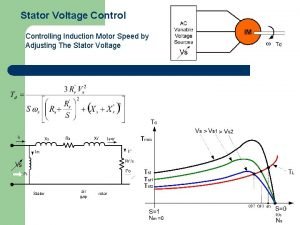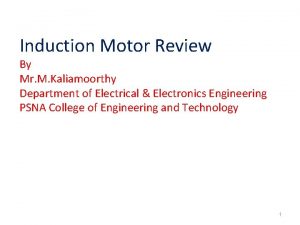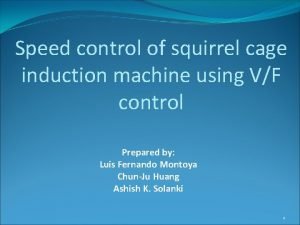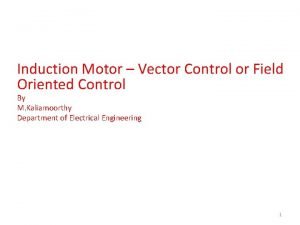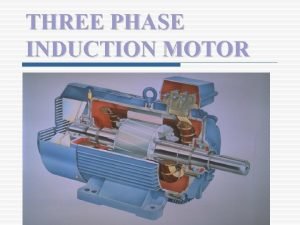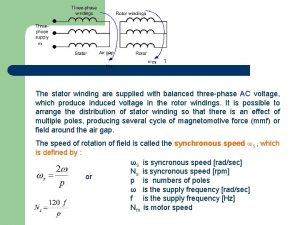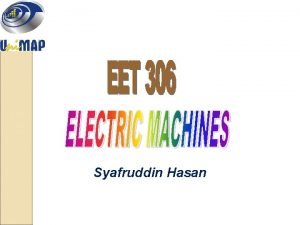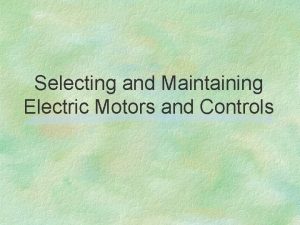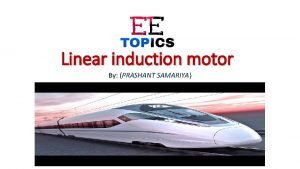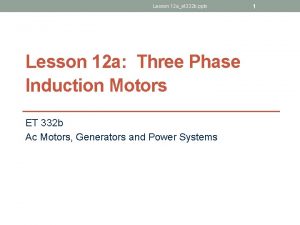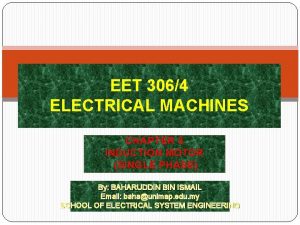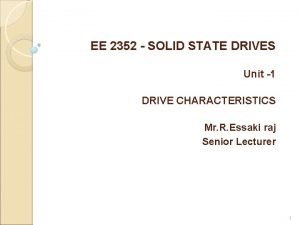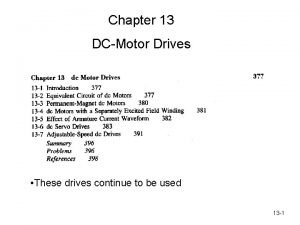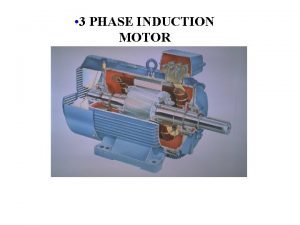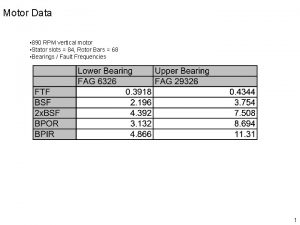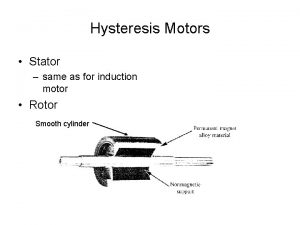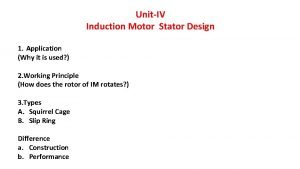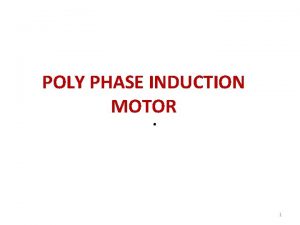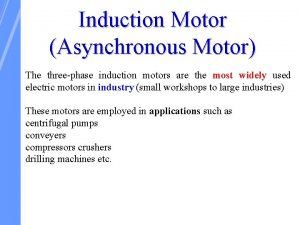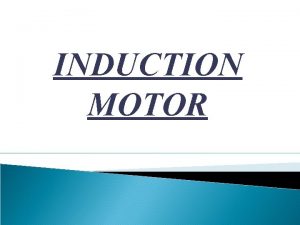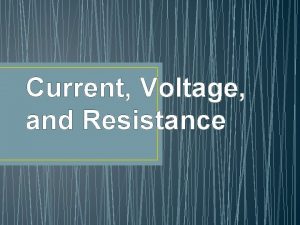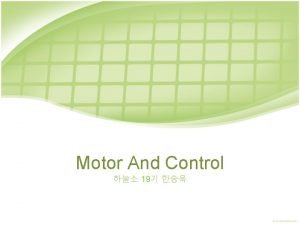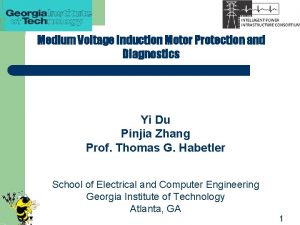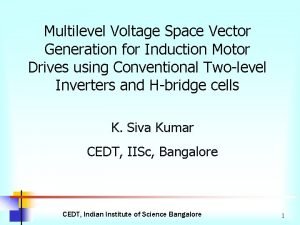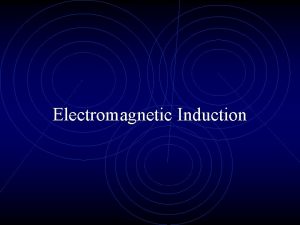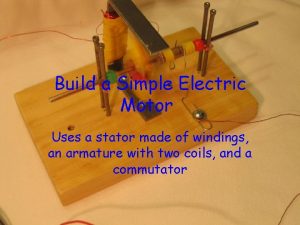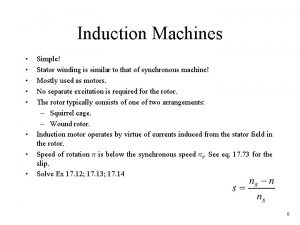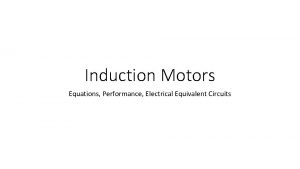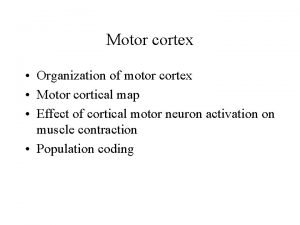INDUCTION MOTOR CONTROL UNIT3 1 Stator voltage control


















- Slides: 18

INDUCTION MOTOR CONTROL UNIT-3

1. Stator voltage control ØThe speed can be controlled by varying the stator voltage. Ø Here the supply frequency is constant. Equivalent circuit of induction motor R 1& X 1 - the stator side resistance & reactance. V 1 - stator voltage (or) supply voltage. f 1 - the supply frequency. I 1, I 2 - the stator and rotor side current respectively. R 2 & X 2 - the rotor resistance & reactance respectively.


Therefore the equation (3. 3) becomes

Results Ø The starting torque α Square of stator voltage, rotor resistance. 1/α The square of the leakage reactance. Ø A small change in stator voltage results in a relatively large change in torque. Ø the slip at maximum torque remains unchanged Figure 3. 2. Speed Vs Torque of Induction motor under stator voltage

Ø It is not a function of voltage. Ø This method is not used for wide range of speed control and constant torque load. Consider ØThe induction motor has no stator copper loss, friction loss, windage and core loss. ØElectrical power converted into mechanical power (developed power in the rotor). Pm = Total air gap power transferred across the air gap for a three phase induction motor (Pag) – copper loss in the rotor (Pcur)


From equation (3. 6) Ø For low speed, slip will be very high. Therefore Efficiency will be poor. Ø It is an excellent method for reducing starting current and increasing the efficiency during light load conditions. Ø The losses are reduced, mainly core losses, which are proportional to the square of the voltage. ØThis method is only suitable for speed control below the rated speed, since the terminal voltage cannot exceeds rated value to prevent the damage of the winding’s insulations.

ØWe have seen that the torque is directly proportional to the transformation ratio K.


1. 1 AC Voltage Controllers fed drive Øby connecting a reverse parallel pair of thyristors or Triac between A. C supply and load, the voltage applied to the load can be controlled. Øwithout change in frequency. applications: - • speed control of poly phase induction motors, • domestic and industrial heating, light controls, • on load transformer tap changing static reactive power compensators etc. Classification • depends on the supply. ü single phase controllers. üThree phase controllers.

Figure 3. 3. Three phase Y connected AC voltage controller circuit ØIn the delta connection, the phase current is times of line current, Ø Thyrsitor current rating is reduced by a factor of Under normal operation Figure 3. 4. Three phase delta connected AC voltage controller circuit

ØEach thyristors is the above circuits are fired in the sequence of their numbers with a phase difference of 60 degree like three phase full converter. Let Rin – Resistance in the induction motor. Xin – Inductive reactance in the induction motor. Therefore, the phase angle For the firing angle , the motor terminal voltage remains constant and nearly equal to the supply voltage. Both motor voltage and current are sinusoidal. For higher values of firing angle , the current flows discontinuously and the motor voltage decreases with an increase in. The zero motor voltage and current are reached at =150 degree and 180 degree

As per the emf equation.


Various Schemes of induction motor speed control


 Stator voltage control of 3 phase induction motor
Stator voltage control of 3 phase induction motor Single phase voltage controller
Single phase voltage controller Induction motor power equation
Induction motor power equation Speed control of squirrel cage induction motor
Speed control of squirrel cage induction motor Principle of vector control of induction motor
Principle of vector control of induction motor Voltage level
Voltage level Phase to phase voltage
Phase to phase voltage Convert rms to peak voltage
Convert rms to peak voltage Objective of earthing
Objective of earthing Maximum torque of induction motor
Maximum torque of induction motor Air gap power in induction motor formula
Air gap power in induction motor formula Power flow diagram of dc motor
Power flow diagram of dc motor Repulsion start induction run motor
Repulsion start induction run motor Construction of linear induction motor
Construction of linear induction motor Rotor frequency formula
Rotor frequency formula Air gap power in induction motor formula
Air gap power in induction motor formula 4 quadrant operation of induction motor
4 quadrant operation of induction motor 4 quadrant operation of induction motor
4 quadrant operation of induction motor Wound rotor
Wound rotor
